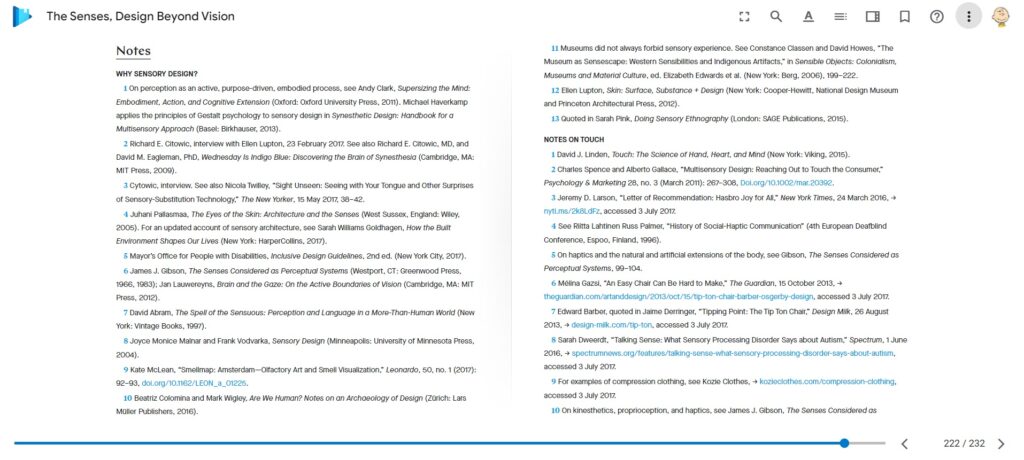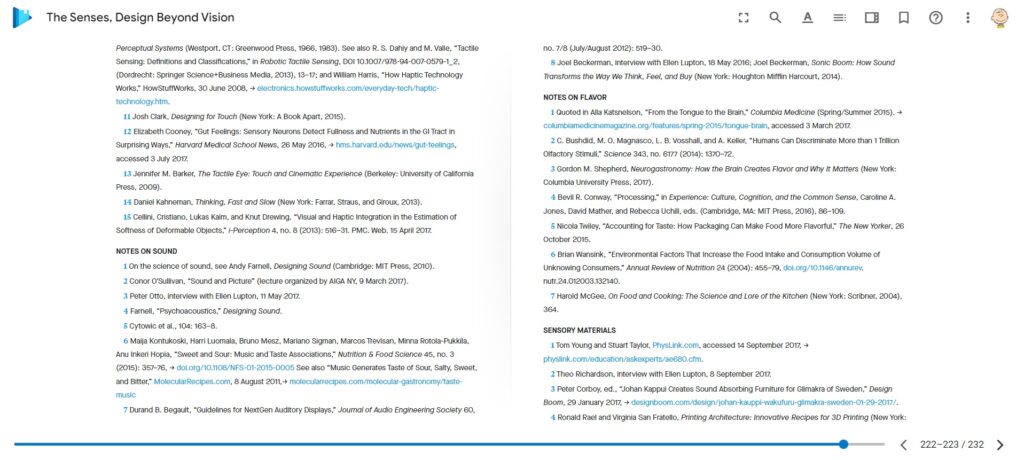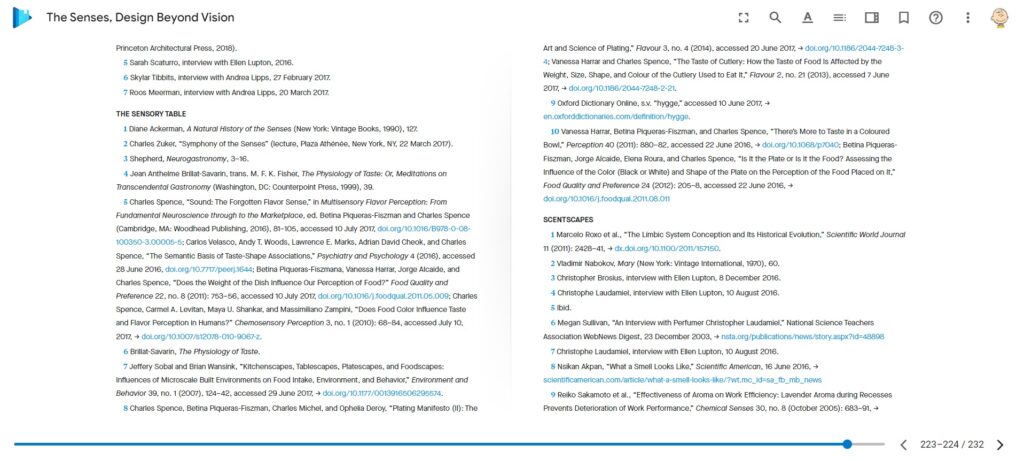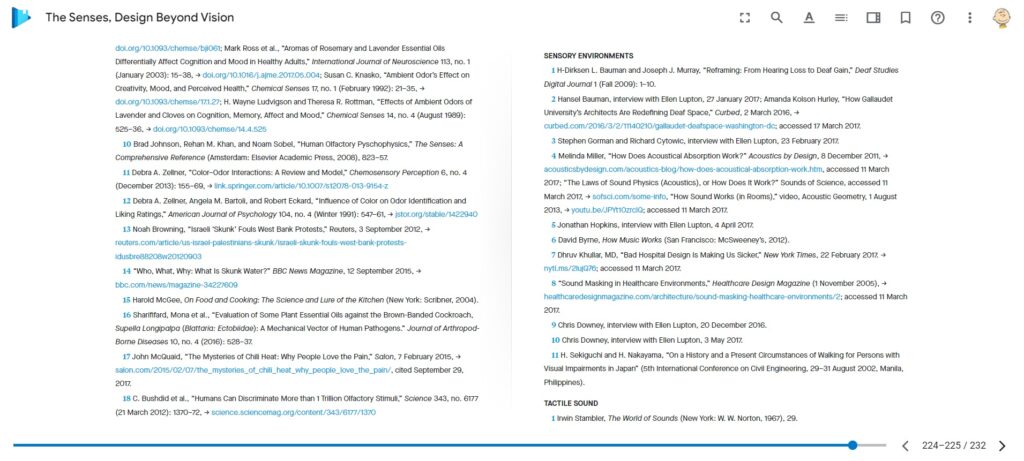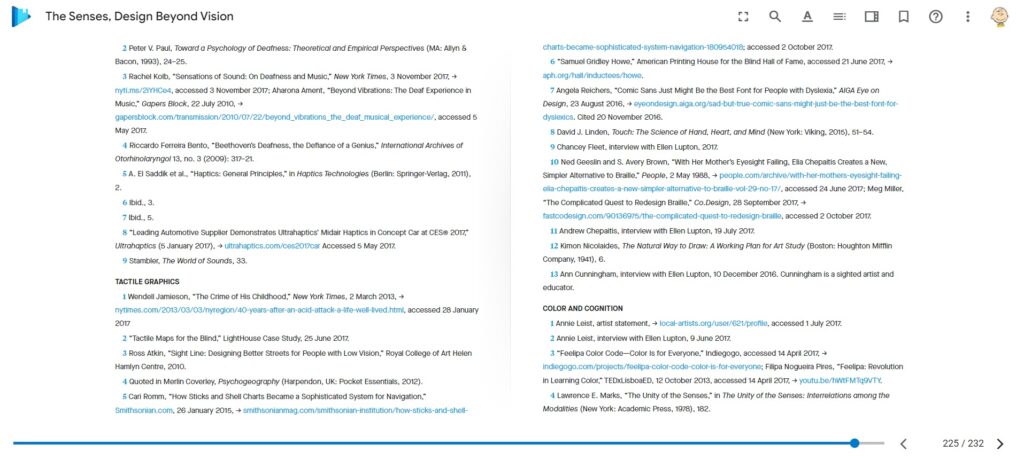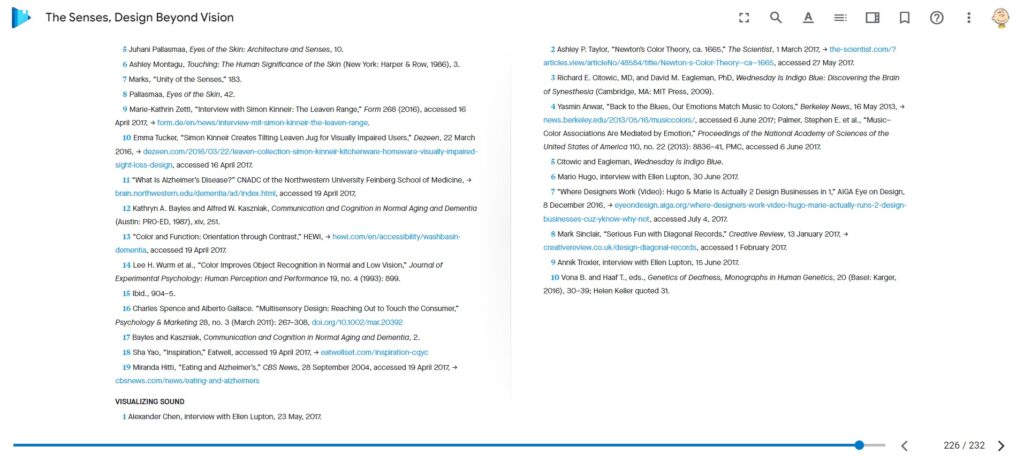- Define purpose
- Who is this for?
- What is the thesis, theme or parti?
- How can the user experience this thesis, etc.? (Lupton, The Senses, Pages 25-26)
- What could be used to provide the thesis, etc.?
- Define senses
- Do not start with the visual
- The visual is too heavily used in design
- Design the visual as the last sense to interact with
- Use the information for only one sense and use different information for the other senses–do not mimic one sense design in another sense (Lupton, The Senses, Pages 25-26)
- Define whether each sense experience is active (using technology) or passive (using materials and objects that are not electronic or electrical)
- Can the sensory design make the intangible perceptible? (MLL, Adaptive Sensory Environments, Page 30)
- If Sense Experience is Passive, what is the object/material? How?
- How to document the sensory experience
- Preliminary and Schematic Design
- Text and Annotations
- Heat Map Diagram
- Design Documentation and Contract Documents
- Tags and Annotations
- Schedules
- Details
- Preliminary and Schematic Design
- If Sense Experience is Active, go to next section
- Do not start with the visual
- Determine active sense experiences
- How many?
- Which Senses?
- How to use the senses?
- What is the desired output?
- What information is being used as an input?
- How are the input and output related?
- Conditional Statement
- Binary Mapping
- One-to-one
- Direct
- Indirect
- Threshold
- Multiple Thresholds
- How to document the sensory experience
- Preliminary and Schematic Design
- Text and Annotations
- Heat Map Diagram
- Design Documentation and Contract Documents
- Tags and Annotations
- Schedules
- Details, Diagrams, and Bill of Materials
- Preliminary and Schematic Design
- What is the hardware to be used for input, processing, and output?
- Description of microcontroller
- Description of Arduino microcontroller
- Board/hardware
- Software
- Sketch
- Description and direction to sensors
- Description and direction of actuators
- Direction to Arduino sketch examples
- Test and Evaluate
- Make Changes as Needed and Retest
Bibliography from Other Books
Adaptive Sensory Environments, An Introduction:
- Addington, M. & Schodek, D. (2005) Smart Materials and New Technologies. Burlington, MA, Elsevier.
- Addington, M. (2006) Smart Materials. In: Beesley P. et al. (ed.) Responsive Architectures: Subtle Technologies. Toronto, ON, Riverside Architectural Press. pp.36–39.
- Azonano (2013) Smart Materials Using Nanotechnology to Produce the Materials to be Used In Applications of the Future. [Online] Available from: http://azonano.com/article.aspx?ArticleID=1877 [Accessed 12 June 2013]
- Bar-Yam, Y. (2011a) Concepts: Adaptive [Online] Available from: http://necsi.edu/guide/concepts/adaptive.html [Accessed 12 June 2013]
- Bar-Yam, Y. (2011b) Concepts: Feedback [Online] Available from: http://necsi.edu/guide/concepts/feedback.html [Accessed 12 June 2013]
- Beesley, P. et al. (2006) Toward Responsive Architectures. In: Beesley P. et al. (ed.) Responsive Architectures: Subtle Technologies. Toronto, ON, Riverside Architectural Press. pp.3–11.
- Beigel, M. (2005) Ubiquitous Computing – Computation Embedded in the World. In: Flachbart G. Weibel P. (ed.), Disappearing Architecture. Basel, Switzerland, Birkhauser. pp.52-61.
- Between the Folds. (2009) [DVD] Green Fuse Films.
- Blesser, B. & Salter, L. (2006) Questions and Answers about: Spaces Speak, Are You Listening? Experiencing Aural Architecture.
- Blesser, B. & Salter, L. (2007) Spaces Speak, Are You Listening? Cambridge, MA, The MIT Press.
- Burnett, R. (2004) How Images Think. Cambridge, Massachussetts. The MIT Press.
- Carroll, J. (2007) The Art of Procrastination. American Way. [Online] Available from http://hub.aa.com/en/aw/piers-steel-the-american-college-university-of-calgary-professor. [Accessed 11 May 2013]
- Cherry, K. (n.d.) What is Brain Plasticity? [Online] Available from: http://psychology.about.com/od/biopsychology/f/brain-plasticity.htm [Accessed 8 June 2015]
- CIPIC Interface Laboratory. (n.d.) Psychoacoustics of Spatial Hearing. [Online] Available from: http://interface.cipic.ucdavis.edu/sound/tutorial/psych.html. [Accessed 5 June 2013]
- Coren, S., Ward, L., Enns, J. (2004) Sensation and Perception: Sixth Edition. United States, John Wiley & Sons, Inc.
- De Kerckhove, D. (2001) The Architecture of Intelligence. Basel, Switzerland, Birkhauser.
- Dickson, D. (1998) Technology That Enhances Visual-Spatial Intelligence. [Online] Available from: http://www.america-tomorrow.com/ati/mi4.htm [Accessed 16 June 2013]
- Dirksen, J. (2012) Design for How People Learn. Berkeley, California. New Riders.
- Duhigg, C. (2012) The Power of Habit: Why We Do What We Do In Life and Business. New York. Random House.
- Dweck, C. (2006) Mindset: The New Psychology of Success. New York. Ballantine Books.
- Eberhard, J. (2006a) See the Space and Hear the Sound of Music. [Online] Available from: http://www.aia.org/aiarchitect/thisweek06/0324/0324eberhard.cfm [Accessed 12 November 2007]
- Eberhard, J. (2006b) How We Use the Brain and Mind to Smell, Taste and Touch. [Online]
- Available from: http://www.aia.org/aiarchitect/thisweek06/0428/0428eberhard.cfm [Accessed 7 November 2007]
- Eberhard, J. (2007) Architecture and the Brain. Atlanta, GA, Greenway Communications, LLC.
- Elvin, G. (2006) Risks in Architectural Applications of Nanotechnology. [Online] Available from: http://nanowerk.com/spotlight/spotid=1007.php [Accessed 12 June 2013]
Elvin, G. (2007a) The Nano Revolution. [Online] Available from: http://architectmagazine.com/curtain-walls/the-nano-revolution.aspx [Accessed 12 June 2013] - Elvin, G. (2007b) The New Era of Nanosensors. [Online] Available from: http://nano-and-society.com/commentaries/commentary_elvin01.html [Accessed 6 November 2007]
ETH Zurich. (2007a) Visualizing Knowledge. [Online] Available from: http://www.ia.arch.ethz.ch/exhibition.htm. [Accessed 7 November 2007] - ETH Zurich. (2007b) The Vision and Reality of Wearable Computing. [Online] Available from: http://www.wearable.ethz.ch/vision.0.html [Accessed 30 October 2007]
Fogg, B.J. (2003) Persuasive Technology. San Fransisco, CA, Morgan Kaufmann Publishers. - Gerber, D. (2014) How to Succeed in Architecture: New Trends in Computing That Will Change the Architectural Profession. [Online] Available from: https://www.youtube.com/watch?v=PWrVvlDIixU#t=815 [Accessed 1 April 2015]
- Glynn, R. (2006) Bridge – Michael Cross. [Online] Available from http://www.interactivearchitecture.org/bridge-michael-cross.htm [Accessed 21 May 2013]
- Glynn, R. (2007a) Flow 5.0 – Daan Roosegaarde. [Online] Available from http://www.interactivearchitecture.org/flow-50-daan-roosegaarde.html [Accessed 21 May 2013]
- Glynn, R. (2007b) Performative Ecologies – Ruairi Glynn. [Online] Available from http://www.interactivearchitecture.org/performative-ecologies-ruairi-glynn.html [Accessed 21 May 2013]
- Goleman, D. (2013) Focus: The Hidden Driver of Excellence. New York, NY. Harper Collins Publishers.
- Greenfield, A. (2006) Everyware. Berkeley, CA, New Riders.
- Hammatt, H. (2002) A World Outside. Landscape Architecture. Issue May 2002
- Harris, L. (2003) The Representation of Space and Time. [Online] Available from http://www.neuroscience.ualberta.ca/archive/summer2003abs.html [Accessed 23 July 2007]
Ishii, H., Ren, S., & Frei, P. (2001) Pinwheels: Visualizing Information Flow in an Architectural Space. CHI, March 31– April 5, 2001. - Johnson, Steven. (2001) Emergence. New York, NY, Scribner.
- Jormakka, K. (2002) Flying Dutchmen: Motion in Architecture. Basel, Switzerland, Birkhauser.
- Khaslavsky, J. & Shedroff, N. (1999) Understanding the Seductive Experience. Communications of the ACM, Vol. 42, No. 5, pp.45–49.
- Kirsh, D. (2000) A Few Thoughts on Cognitive Overload. Intellectica. [Online] Available from: http://interactivity.ucsd.edu/articles/Overload/published.html. [Accessed 15 November 2007]
- Kronenburg, R. (2007) Flexible: Architecture that Responds to Change. London, Laurence King Publishing.
- Lang, R.J. and McArthur, M. (2013) Folding Paper. Rutland, Vermont. Tuttle Publishing.
- Lenau, T. (2008) Responsive (Smart) Materials. [Online] Available from: http://designinsite.dk/htmsider/md950.htm [Accessed 12 June 2013]
- Leyton, M. (2006) Shape as Memory: A Geometric Theory of Architecture. Basel, Switzerland, Birkhauser.
- Libet, B. (2004) Mind Time. Cambridge, MA, Harvard University Press.
- Livingstone, M. (2002) Vision and Art: The Biology of Seeing. New York, NY, Harry N. Abrams.
- Lutz. J. (2006) Breaking the Architectural Sound Barrier. In: Beesley P. et al. (ed.) Responsive, Architectures: Subtle Technologies. Toronto, ON, Riverside Architectural Press. pp.85–87.
- Mahnke, F. H. (1996) Color, Environment, & Human Response. New York, NY, John Wiley & Sons, Inc.
- Malnar J. M. & Vodvarka, F. (2004) Sensory Design. Minneapolis, MN, University of Minnesota Press.
- Mangelsen, L. (2005) Perception. [Online] Available from: http://itp.nyu.edu/spatialdesign/blog/archives/2005/11/perception.html [Accessed 21 November 2007]
- Meadows, D.H. (2008) Thinking In Systems. White River Junction, Vermont. Chelsea Green Publishing.
- Meyers-Levy, J. (2007) Ceiling Height Can Affect How a Person Thinks, Feels, and Acts. [Online] Available from: http://www1.umn.edu/urelate/national/stories/ceilings.php [Accessed 16 June 2013]
- Mitchell, W. (2005) After the Revolution – Instruments of Displacement. In: Flachbart G. Weibel P. (ed.), Disappearing Architecture. Basel, Switzerland, Birkhauser. pp.18-23.
- Noë, A. (2004) Action In Perception. Cambridge, MA, The MIT Press.
- NOVA: Cracking Your Genetic Code. (2012) [DVD] PBS.
- Olson, J. (2011) The Slight Edge: Turning Simple Disciplines Into Massive Success. Lake Dallas, Texas. Success Books.
- Oosterhuis, K. (2002) E-motive House. [Online] Available from: http://www.oosterhuis.nl/quickstart/index.php?id=348 [Accessed 21 May 2013]
- Oosterhuis, K. (2005) Protospace 2.0: The ITC-driven Collaborative Design Working Space. In: Flachbart G. Weibel P. (ed.), Disappearing Architecture. Basel, Switzerland, Birhauser. pp.118–131.
- Organised 1st. (n.d.) Cognitive Overload. [Online] Available from: http://www.org1st.com/cognitive_overload.htm. [Accessed 15 November 2007]
- Pallasmaa, J. (2007) The Eyes of the Skin. West Sussex, England, John Wiley & Sons Ltd.
- Pallasmaa, J. (2008) Hapticity and Time. [Online] Available from: http://iris.nyit.edu/~rcody/Thesis/Readings/Pallasmaa%20-%20Hapticity%20and%20Time.pdf [Accessed 14 June 2013]
- Pescovitz, D., Tester, J., & Love, M. (2007) Sensory Transformation: New Tools and Practices for Overcoming Cognitive Overload. Technology Horizons Program. Report No. SR-1075.
- Puglisi, L. (1999) Hyper Architecture. Basel, Switzerland, Birkhauser.
- Rasmussen, S. (1982) Experiencing Architecture. Cambridge, MA, The MIT Press.
- Reade, Q. (2005) HR Productivity Hit by Workplace Distractions. [Online] Available from: http://www.personneltoday.com/articles/13/01/2005/27410/hr-productivity-hit-by-workplace-distractions.htm [Accessed 16 June 2013]
- Sapolsky, R. (2004) Why Zebras Don’t Get Ulcers. New York, NY, Henry Holt and Company, LLC.
- Smart Dust. (2007) Smart Dust Project. [Online] Available from: http://chemtrails911.com/docs/-%202007/Smart%20Dust.htm [Accessed 12 June 2013]
- Smith, J. et al. (2004) The Elements of a Caring Environment. [Online] Available from: http://www.healthcaredesignmagazine.com/article/elements-caring-environment [Accessed 22 May 2013]
- Strauss, W. & Fleischmann, M. (2005) Implosion of Numbers – Performative Mixed Reality. In: Flachbart G. Weibel P. (ed.), Disappearing Architecture. Basel, Switzerland, Birhauser. pp.118–131.
- Streitz, N. A., Rocker C., Prante Th., Stenzel, R., van Alphen, D. (2003) Situated Interaction with Ambient Information: Facilitating Awareness and Communication in Ubiquitous Work Environments. In: Tenth International Conference on Human-Computer Interaction (HCI International 2003), June 22–27, 2003.
- Sylvester, T. (2013) Designing Games. Sebastopol, California. O’Reilly.
- Terzidis, K. (2003) Expressive Form: A Conceptual Approach to Computational Design. London, Spon Press.
- The Brain Fitness Program (2007) [DVD] Santa Fe Productions.
- Thompson, C. (2013) Relying on Algorithms and Bots Can Be Really, Really Dangerous. [Online] Available from: http://www.wired.com/2013/03/clive-thompson-2104 [Accessed 1 April 2015]
- Twist, J. (2004) Myths and Realities of Nano Futures. [Online] Available from: http://news.bbc.co.uk/2/hi/science/nature/3920685.stm [Accessed 12 June 2013]
- Tzonis, A. (1999) Schools without Walls. In: Santiago Calatrava: The Poetics of Movement. New York, Universe. pp.14–29.
- University of Michigan (2008) Going Outside – Even in Cold – Improves Memory, Attention. [Online] Available from: http://ns.umich.edu/new/releases/6892/ [Accessed 16 June 2013]
- Weinstock, M. & Mehran, G. (2013) Intelligent Cities and the Taxonomy of Cognitive Scales. In Weinstock M. (ed.) System City: Infrastructure and the Space of Flows. London. John Wiley & Sons.
- What Plants Talk About (2013) [DVD] Merit Motion Pictures.
- Wikibooks. (2006) Systems Theory/Evolution & Growth. [Online] Available from: http://en.wikibooks.org/wiki/SystemsTheory/Evolution%26_Growth [Accessed 1 April 2015]
